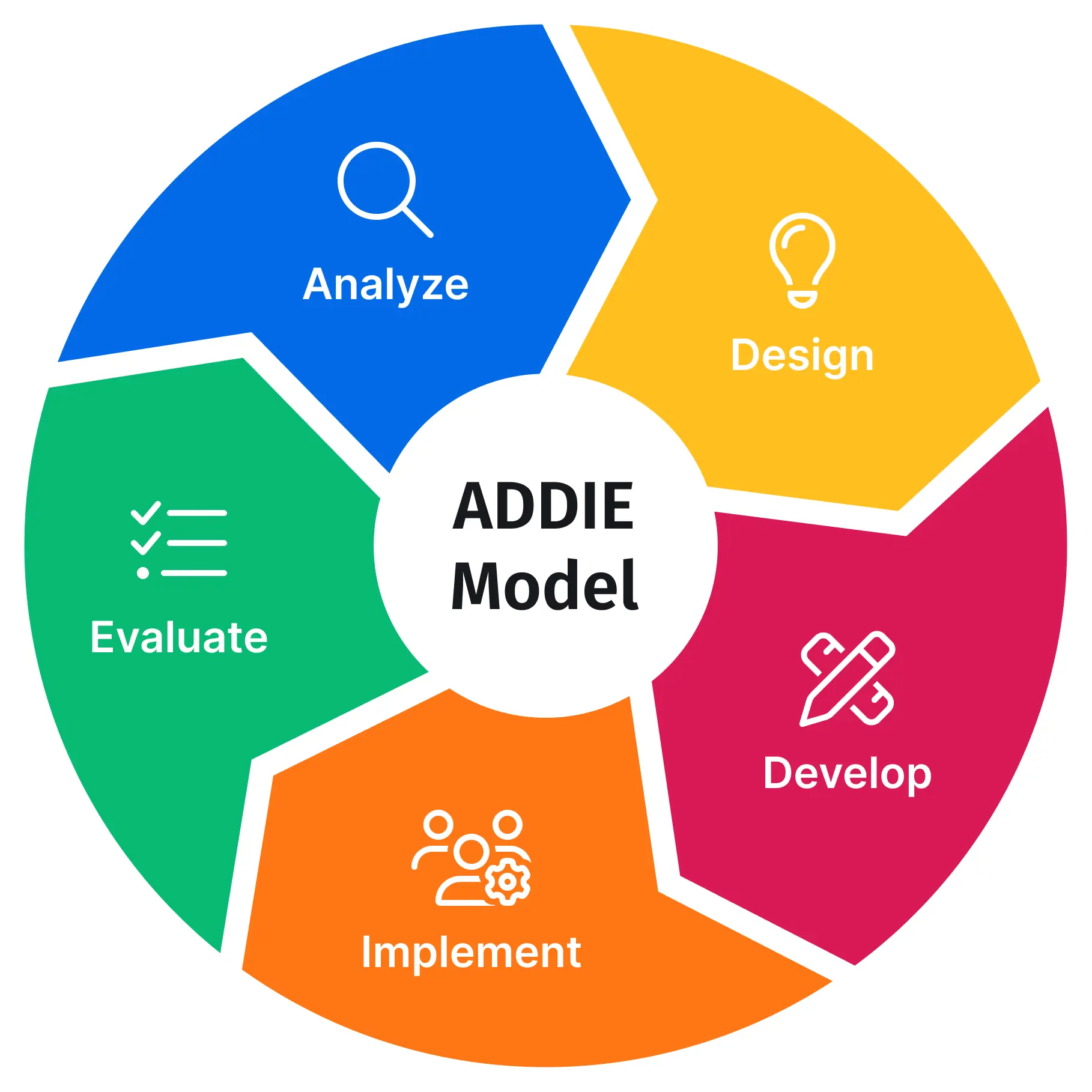ADDIE
ADDIE is a core instructional design model that uses five phases: Analysis, Design, Development, Implementation, and Evaluation, to build effective, learner-focused training that improves over time.
ADDIE Model
Overview
The ADDIE model is a cornerstone of instructional design, providing a structured yet adaptable framework for developing effective learning experiences. Its five phases: Analysis, Design, Development, Implementation, and Evaluation, create a systematic process that ensures instruction is aligned with real performance needs, grounded in learner characteristics, and continuously improved through feedback.
Unlike linear models, ADDIE is iterative: findings in later phases often lead back to adjustments in earlier ones, making it a dynamic tool for addressing complex instructional challenges in education, training, and professional development.

1. Analysis
The analysis phase is the foundation of instructional design. Its purpose is to clarify the problem, define goals, and understand the learners and context before any instruction is created. Without proper analysis, instruction risks being misaligned with actual needs, wasting resources and learner time. Analysis ensures the course is addressing the right problem, not just a perceived one.
Key components of analysis include:
- Needs Analysis: Determines the gap between current performance and desired performance. This clarifies whether training is the right solution.
- Learner Analysis: Examines who the learners are: their demographics, prior knowledge, motivations, and potential barriers.
- Job-Task Analysis: Breaks down what learners must be able to do, identifying the skills and knowledge required for successful performance.
- Context Analysis: Considers the environment in which instruction will occur, including technological, cultural, and organizational factors.
"Together, these analyses ensure the instructional problem is accurately defined and the goals are realistic and relevant."
2. Design
The design phase builds on the findings of analysis by establishing the instructional blueprint. This stage focuses on aligning learning objectives, content, and assessment strategies in a coherent plan. The strength of this phase is intentionality: Every activity and assessment is deliberately chosen to support specific objectives.
Key components of design include:
- Learning Objectives: Written in measurable terms, often using Bloom's Taxonomy, to define what learners will know or do by the end of instruction.
- Instructional Strategies: Choosing the best methods to meet objectives, such as case studies, scenarios, or problem-based learning.
- Assessment Planning: Designing formative and summative assessments that directly measure achievement of objectives.
- Design Document: A detailed plan outlining objectives, instructional strategies, content scope, media choices, and assessment methods. This serves as a shared reference for stakeholders and developers.
"By the end of design, the course has a clear roadmap ensuring alignment between learning needs, objectives, and instructional methods."
3. Development
The development phase is where the instructional plan becomes tangible. Building on the design document, materials are created, tested, and refined. The focus here is execution: transforming plans into actual instructional products/materials that are accurate, engaging, and accessible.
Key components of development include:
- Content Creation: Developing instructional text, graphics, videos, and activities that align with objectives.
- Prototyping: Producing small-scale versions of lessons or activities to test design assumptions before full rollout.
- Technology Integration: Building modules in authoring tools or learning platforms, ensuring compatibility and usability.
- Quality Assurance: Reviewing content for clarity, accuracy, and accessibility, and conducting pilot testing to identify and resolve issues.
"Development ensures that instructional materials are not only built but validated before delivery."
4. Implementation
Implementation is the phase where learners finally interact with the instruction. The purpose here is to deliver materials effectively, support both facilitators and learners, and manage the logistics of deployment. Successful implementation requires preparation and monitoring to ensure the learning experience is seamless.
Key components of implementation include:
- Instructor or Facilitator Preparation: Training instructors on content and delivery methods when applicable.
- Learner Orientation: Preparing learners with instructions, prerequisites, or technical support to set them up for success.
- Logistics: Configuring the learning environment, whether a classroom or LMS, and ensuring access to materials and tools.
- Delivery: Executing the instruction, monitoring engagement, and providing support throughout the process.
"Implementation ensures that what was designed and developed is experienced by learners as intended, with minimal barriers."
5. Evaluation
Evaluation validates the effectiveness of the instructional solution. It is not confined to the end of the process but occurs throughout, guiding adjustments and improvements. The purpose of evaluation is twofold: to measure learning outcomes and to improve the instructional design itself.
Key components of evaluation include:
- Formative Evaluation: Conducted during each ADDIE phase to catch issues early and refine materials before full implementation.
- Summative Evaluation: Conducted after delivery to measure overall effectiveness and impact.
-
Kirkpatrick's Four Levels of Evaluation:
- Reaction: Learner satisfaction and engagement.
- Learning: Knowledge or skills acquired.
- Behavior: Transfer of learning to real-world performance.
- Results: Organizational or broader outcomes achieved.
"Through evaluation, instructional designers ensure that instruction is achieving its goals and gather insights for future iterations."
The ADDIE model provides more than a step-by-step process. It is a cycle of continuous improvement. Each phase builds on the last, while evaluation ensures that instruction remains relevant, aligned, and effective. Its detailed approach to analysis, systematic design, careful development, structured implementation, and rigorous evaluation makes it a foundational tool for instructional designers committed to creating impactful learning experiences.
Implications of the ADDIE Model for Instructional (Learning) Design
The ADDIE model has significant implications for how instructional design is practiced because it enforces a systematic, evidence-based approach rather than relying on intuition or ad-hoc methods. Its structure ensures that instruction is purposeful, measurable, and responsive to learner and organizational needs.
1. Ensuring Alignment and Relevance
By starting with analysis, ADDIE compels designers to ground their work in actual performance gaps and learner characteristics. This reduces the risk of producing training that is misaligned with needs or irrelevant to learners' contexts. In practice, this means instructional solutions are more targeted, cost-effective, and likely to achieve desired outcomes.
2. Promoting Measurable Outcomes
The design phase emphasizes writing clear, measurable objectives, which creates a direct line between instruction and evaluation. This ensures that every activity and assessment can be justified in terms of its contribution to learning outcomes. The implication is that instructional design becomes more accountable, with demonstrable evidence of effectiveness.
3. Improving Quality and Consistency
Development within the ADDIE model provides a structured way to build and test instructional materials before they are delivered. This systematic approach to prototyping and quality assurance increases the reliability of materials, minimizes errors, and results in more consistent learner experiences across contexts.
4. Supporting Scalable and Sustainable Learning
Implementation guided by ADDIE highlights the logistical and human factors necessary for successful delivery. Preparing instructors, orienting learners, and ensuring accessibility means courses can be scaled to different audiences while maintaining quality. This is particularly important for organizations that need to deliver training across multiple sites or diverse populations.
5. Driving Continuous Improvement
Perhaps the most critical implication comes from evaluation. By embedding both formative and summative evaluation, ADDIE positions instructional design as a cycle of continuous improvement rather than a one-time event. Using frameworks like Kirkpatrick's Four Levels allows designers not only to measure satisfaction and knowledge but also to track behavior change and organizational impact.
"The ADDIE model ensures instructional design is systematic, measurable, and adaptable, positioning designers as strategic partners in creating meaningful learning outcomes."


